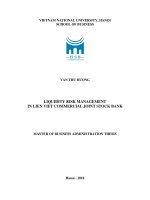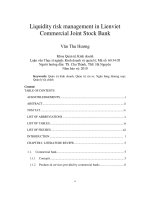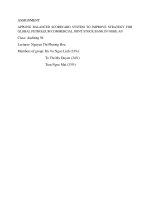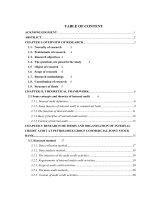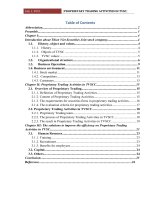LIQUIDITY RISK MANAGEMENT IN LIEN VIET COMMERCIAL JOINT STOCK BANK
Bạn đang xem bản rút gọn của tài liệu. Xem và tải ngay bản đầy đủ của tài liệu tại đây (737.25 KB, 124 trang )
VIETNAM NATIONAL UNIVERSITY, HANOI
SCHOOL OF BUSINESS
VAN THU HUONG
LIQUIDITY RISK MANAGEMENT
IN LIEN VIET COMMERCIAL JOINT STOCK BANK
MASTER OF BUSINESS ADMINISTRATION THESIS
Hanoi - 2010
VIETNAM NATIONAL UNIVERSITY, HANOI
SCHOOL OF BUSINESS
VAN THU HUONG
LIQUIDITY RISK MANAGEMENT
IN LIEN VIET COMMERCIAL JOINT STOCK BANK
Major: Business Administration
Code: 60 34 05
MASTER OF BUSINESS ADMINISTRATION THESIS
Supervisors:
1. Dr. Chu Thanh
2. MBA Ha Nguyen
Hanoi - 2010
vi
TABLE OF CONTENTS
ACKNOWLEDGEMENTS i
ABSTRACT ii
TÓM TẮT iv
LIST OF ABBREVIATIONS x
LIST OF TABLES xi
LIST OF FIGURES xii
INTRODUCTION 1
CHAPTER I: LITERATURE REVIEW 5
1.1. Commercial bank 5
1.1.1 Concepts 5
1.1.2 Products & services provided by commercial banks 6
1.1.3 Roles of commercial bank in economics 6
1.2. Risk management in Commercial Bank 7
1.2.1. Risk in commercial bank 7
1.2.2. Main risks in Commercial Bank 8
1.2.3. Risk Management in Commercial Bank 8
1.3. Liquidity Risk Management in Commercial Bank 10
1.3.1. Defining liquidity risk 10
1.3.2. Basel and Basel II requirements 12
1.3.3. International Framework for Liquidity Risk Management in Commercial
Bank 16
1.3.3.1. Liquidity risk tolerance 18
vii
1.3.3.2. Strategy & Policy 18
1.3.3.3. The responsibilities to manage liquidity risk 19
1.3.3.4. Liquidity Risk Management Process 21
1.3.3.5. Contingency Planning 25
1.3.3.6. Internal Audit 27
1.4. Liquidity risk in Vietnam Commercial bank system 27
1.4.1. Some typical events of liquidly risk in Viet Nam before year 2006 27
1.4.2. From the beginning of year 2006 to the end of year 2007: 28
1.4.3. From the beginning of year 2008 – the end of year 2008 29
1.4.4. From the beginning of year 2009 to the ending of year 2009 30
1.4.5. The first six months of year 2010 31
1.4.6. Summarized main reasons for liquidity crunch 32
1.5. State Bank of Vietnam regulations 33
1.6. Practices for liquidity risk management 37
1.6.1. The Hongkong and Shanghai Bank Corporation 37
1.6.2. Asia Commercial Bank 38
CHAPTER 2. LIQUIDITY RISK MANAGEMENT IN LIENVIETBANK 41
2.1. Overview on LienVietBank 41
2.1.1. Introduction 41
2.1.2. Business Results 44
2.1.3. Organization structure 44
2.2. Liquidity risk in LienVietBank 45
2.2.1. SBV’s regulations on liquidity ratios in the activities of credit institution
viii
46
2.2.2. Supplies of Liquidity 47
2.2.2.1. Liquid Assets 48
2.2.2.2. Loans repayment 53
2.2.2.3. Total mobilized funds and chartered capital 55
2.2.3. Measurement of Liquidity risk via Gap Analysis 59
2.2.3.1. LienVietBank’s Liquidity Gap report in VND (see table 2-11) 60
2.2.3.2. LienVietBank’s Liquidity Gap report in USD (see table 2-12) 63
2.2.4. Assessment on current status of liquidity risk 65
2.3. General situation of risk management at LienVietBank 67
2.3.1. From establishment to end 2008 67
2.3.2. For the year of 2009 68
2.3.3. From the beginning of 2010 to now 69
2.4. Liquidity risk management in LienVietBank 69
2.4.1. Strategy and Policy 69
2.4.2. The responsibilities to manage liquidity risk 71
2.4.3. Process of liquidity risk management 74
2.4.4. Internal Audit 75
2.4.5. Contingency Plan 75
2.5. Assessment on liquidity risk management in LienVietBank 76
2.5.1. Achievements 77
2.5.2. Drawbacks on the current liquidity risk management in LienVietBank 78
2.5.2.1. Strategy and policy 78
ix
2.5.2.2. Organization structure 78
2.5.2.3. Process of liquidity risk management and contingency plan 79
2.5.2.4. Management information system 79
2.5.2.5. Human resource 80
CHAPTER 3 RECOMMENDATIONS AND SOLUTIONS 82
3.1 Some petitions for LienVietBank 82
3.1.1 Building a culture of risk management in LienVietBank 82
3.1.2 Building Liquidity risk strategy and policy 84
3.1.3 Improving organizational structure 87
3.1.4 Building process of liquidity risk management 90
3.1.5 Building contingency plan 97
3.1.6 Improving management information system 99
3.1.7 Improving human resources 100
3.1.8 Action planning 102
3.2. Some petitions for SBV 107
3.3. Some petitions for Government 108
Conclusion 109
REFERENCE 110
Appendix 1 112
Appendix 2 113
Appendix 3 114
Appendix 4 115
x
LIST OF ABBREVIATIONS
ACB Asia Commercial Bank
ALCO Asset and Liability Committee
BOD Board of Directors
BOM Board of Management
CAR Capital Equity Ratio
HR Human Resource
LVB LienViet Commercial Joint Stock bank
NPLs Non performing loans
SBV State Bank of Viet Nam
Sacombank Sai Gon Thuong Tin bank
TCB Vietnam Technological and Commercial Joint stock bank
VCB The Bank for Foreign Trade of Vietnam
xi
LIST OF TABLES
Table 1-1: Products & services provided by commercial banks 6
Table 1-2: Summarized the principles of Basel 2 14
Table 1-3: International Framework for Liquidity Risk Management in Commercial
Bank 17
Table 1-4: The differences between Decision No.457 and Circular 15 & 13 36
Table 2-1: Business Results - LienVietBank 44
Table 2-2: Comparison of the liquidity ratios 46
Table 2-3: The ratio of liquid assets to total assets 49
Table 2-4: Comparison of the ratio of liquid assets to total assets 50
Table 2-5: The average ratio of the component to liquid assets 51
Table 2-6: Comparison of the portion of the items out of liquid assets 52
Table 2-7: Some indicators of loans quality 54
Table 2-8: Comparison of loans quality by NPL ratio 55
Table 2-9: Comparison of LDR 55
Table 2-10: Mobilized funds from corporate and individuals of LienVietBank 57
Table 2-11: LienVietBank’s Liquidity Gap report in VND 62
Table 2-12: LienVietBank’s Liquidity Gap report in USD 64
Table 2-13: Summarize assessment on current status of liquidity risk in
LienVietBank 65
Table 3-1: Recommendation for Process of liquidity risk management (content) 91
Table 3-2: Recommendation for Contingency plan sample 98
Table 3-3: Recommendation for Action planning 103
xii
LIST OF FIGURES
Figure 1- 1: Three pillars of Basel II 13
Figure 2-1: Comparison of the ratio of liquid assets to total assets 50
Figure 2-2: Total mobilized funds of LVB 56
Figure 2-3: The number of accounts of incoming customer deposits 58
Figure 2-4: Rating liquidity risk management in LVB 77
Figure 3-1: Overview on chapter 3……………………………………………… 81
Figure 3-2: Recommendation for Organization structure 87
Figure 3-2: Recommendation for Process of liquidity risk management (procedures)
95
1
INTRODUCTION
1 Necessity of the thesis
The nature of the bank is making a profit based on business risk. In banking
activities many types of risk exist (credit risk, liquidity risk, market risk, etc.). In
Vietnam, the banking activities are often associated with credit risk. However,
liquidity risk, the type of risks that can immediately make a bank collapse is less
focused, because if the banking activities took place on a normal schedule, the
risk was not disclosed. Only when a certain event happens to have a negative
impact on the bank, then the liquidity risk is exposed, in the worst case, banks
have no liquidity, leading to bankruptcy, and affecting the entire banking
system.
In Vietnam, liquidity risk can be a problem just say "old problem" was just a
matter of "new problem". Calling it "an old problem" is because any bank
manager knows about this kind of risk, understands the importance of it and they
are also managing liquidity risk based on experience and traditional methods.
And calling it "a new problem" is because not many banks in Vietnam really
understand it and find ways to reach new approaches to liquidity risk
management by international standards. Only after the events on the liquidity
risk from 2006 through to now did banks begin to explore and consciously
implement the management of liquidity risk, according to a scientific and more
systematic method. The starting point of that process must be derived from the
banks which are fully equipped with theoretical knowledge about liquidity risk
management.
LienVietBank was established in April 2008, and in more than 2 years the bank
has gained outstanding achievements in business results, but besides that, the
issues of risk management are all complex. The organizational structure is not
stable, risk management personnel frequently change, the bank only cares about
2
credit risk management and pays no attention to risk management activities,
particularly the management liquidity risk.
And if there is a crisis similar to the liquidity crisis in 2008, the bank will face
the enormous difficulty. It is the reason why I decided to choose the topic
“Liquidity risk management in Lien Viet Commercial Joint Stock Bank” for my
thesis.
2 Research Objective
The aim of the research is to analyze and assess the current status of liquidity
risk management in LienVietBank and to propose appropriate recommendations
to enhance the efficiency in liquidity risk management in LienVietBank. The
thesis therefore aims to achieve the following objectives:
Systemize the basic theoretical problem about liquidity risk and liquidity risk
management in commercial banking.
Identifying and assess current situations of liquidity risk and liquidity risk
management in LienVietBank.
Propose recommendations and solutions to enhance the efficiency in
liquidity risk management in LienVietBank.
3 Research Scope
For the purpose and requirement of an MBA graduate thesis, the thesis only
focuses on liquidity risk and liquidity risk management in Lien Viet Commercial
Joint stock bank.
4 Information sources
Statistic data gathered at LienVietBank (financial statements, official
releases of LienVietBank).
Data from other sources such as other banks, books, internet, related journals
3
and periodic, science reviews.
Information gathered from direct observation as a person directly involved in
activities related.
5 Research Methodology
The research methodology of the thesis is the combination of both qualitative
and quantitative to analyze data and information, make comparisons, evaluations
and conclusions on current situation of liquidity risk management in
LienVietBank.
6 Limitation
The assessment focuses on the liquidity risk management in LienVietBank, due
to time constraint, limited analysis tools and the ability to approach data sources
the research can not be analyzed fully and deeply all aspects of the problem.
7 Expected result
Thesis systematizes the basic knowledge of liquidity risk management in
commercial bank, to apply this knowledge to assess liquidity risk and liquidity
risk management in LienVietBank. From there thesis contributes practical ideas
to LienVietBank to improve liquidity risk management, enhance
competitiveness of LienVietBank in the market.
8 Thesis structure
TOPIC: “Liquidity risk management in LienViet Commercial Joint stock bank
(LienVietBank)”
Introduction
Chapter 1: Literature Review
Chapter 2: Liquidity risk management in LienVietBank
4
Chapter 3: Recommendations and Solutions
Conclusion
References
5
CHAPTER I: LITERATURE REVIEW
This chapter aims to answer the research questions about liquidity risk. Firstly,
definitions related to commercial bank, risk management in commercial bank.
Secondly and finally, definitions related to liquidity risk and liquidity risk
management in commercial bank, expressing by Basel II and international
framework for liquidity risk management.
1.1. Commercial bank
1.1.1 Concepts
There is still much confusion about what exactly a commercial bank is. And
many definitions have been given by organizations. "Commercial banks" can be
defined based on: (1) Its function in the economy; (2) The services it offers to
customers or (3) based on legal institutions that exist:
“A financial institution that accepts demand deposits and makes loans and
provides other services for the public”
1
.
“A full-service institution that offers customers deposit, payment and credit
services, in addition to other financial services”
2
.
“A financial intermediary which collects credit from lenders in the form of
deposits and lends in the form of loans”.
3
Finally, there is a definition “commercial bank” still used by many nations
today: The bank that sells deposits and makes loan to businesses and
individual
4
.
1
Source: wordnetweb.princeton.edu/per1/webwn
2
Source: arcuclesbase.com
3
Source:
4
Source: S.Rose, Peter and C.Hudgins, Sylvia, (2008), Bank management & Financial Services, page 6
6
1.1.2 Products & services provided by commercial banks
Commercial banks offer many types of products and services which can be
summarized as below:
Table 1-1: Products & services provided by commercial banks
1
Products & Services Content
Liability products
Represent liabilities of the bank, include checking and
savings accounts, certificates of deposit and other
types of deposit products
Asset Products
Represent the primary assets of the banks, these
products normally take the form of personal and
business loans, mortgages, auto loans and credit cards
Electronic banking
Include the maintenance and expansion of 24-hour
ATM networks, wire transfers and banking websites
that allow consumers and business to obtain account
information, open new accounts, order checks, transfer
funds between accounts and make bill payments
Other Services
Include investment advisory services, corporate
finance consulting, custodial services for estates and
trusts, safekeeping of securities and other valuable
items, and money transfer services
1.1.3 Roles of commercial bank in economics
Commercial banks play an important role in economic development. Economic
development involves investment in various sectors of economy. Commercial
banks collect savings from the people and mobilize saving for investment in
industrial project or making loans to individuals. The investors borrow from
banks to finance the projects. Special funds are provided to the investors for the
1
Source: John B.King, 2010, Ehow contributor journal
7
completion of projects. Commercial banks also represent a vital link in the
transmission of government’s economic policies to the rest of the economy,
when bank credit is scare and expensive, spending in the economy tends to slow
and unemployment usually increase. Or if interest rates are very high, the cost of
bank credit will be high and this could be inflationary.
1.2. Risk management in Commercial Bank
1.2.1. Risk in commercial bank
1
Risk in a banking organization is possibility that the outcome of an action or
event could bring up adverse impacts. Such outcomes could either result in a
direct loss of earnings/capital or may result in imposition of constraints on
bank’s ability to meet its business objectives. Such constraints pose a risk as
these could hinder a bank's ability to conduct its ongoing business or to take
benefit of opportunities to enhance its business.
Banks often distinguish between expected and unexpected losses. Expected
losses are those that the bank knows with reasonable certainty will occur (e.g.,
the expected default rate of corporate loan portfolio or credit card portfolio) and
are typically reserved for in some manner. Unexpected losses are those
associated with unforeseen events (e.g. losses experienced by banks in the
aftermath of nuclear tests, Losses due to a sudden down turn in economy or
falling interest rates). Banks rely on their capital as a buffer to absorb such
losses.
Risks are usually defined by the adverse impact on profitability of several
distinct sources of uncertainty. While the types and degree of risks an
organization may be exposed to depend upon a number of factors such as its
size, complexity business activities, volume etc, it is believed that generally the
1
State Bank of Pakistan, (2002), Risk Management- Guideline for Commercial Banks & DFIs, page
1
8
banks face Credit, Market, Liquidity, Operational,
Compliance/Legal/Regulatory and reputation risks. Before overarching these
risk categories, given below are some basics about risk Management and some
guiding principles to manage risks in banking organization.
1.2.2. Main risks in Commercial Bank
Banks face a number of risks in order to conduct their business, and there have
been four main risks faced by commercial banks include:
Credit risk arises from the potential that an obligor is either unwilling to perform
on an obligation or its ability to perform such obligation is impaired resulting in
economic loss to the bank.
1
Market Risk: It is the risk that the value of on and off-balance sheet positions of
a financial institution will be adversely affected by movements in market rates
or prices such as interest rates, foreign exchange rates, equity prices, credit
spreads and/or commodity prices resulting in a loss to earnings and capital
2
.
Liquidity Risk: Liquidity is the ability of a bank to fund increases in assets and
meet obligations as they come due, without incurring unacceptable losses.
3
Operational Risk: the risk of loss resulting from inadequate or failed internal
processes, people and systems or from external events. The definition includes
legal risk but excludes strategic and reputational risk.
4
1.2.3. Risk Management in Commercial Bank
1
1
State Bank of Pakistan, (2002), Risk Management- Guideline for Commercial Banks & DFIs, page 5
2
State Bank of Pakistan, (2002), Risk Management- Guideline for Commercial Banks & DFIs, page 17
3
Source: Basel Committee on Banking Supervision, (2008), Principles for sound liquidity risk management
and supervision, page 1
4
Source: Bank for International Settlements, Sound Practices for the Management and Supervision of
Operational Risk, ,page 2
9
“Banks are in the Business of Managing Risk, Pure and Simple, that is the
Business of Banking” (Walter Wriston, Chairman an CEO Citicorp 1970-
1984)”
The acceptance and management of financial risk is inherent to the business of
banking and banks’ roles as financial intermediaries. Risk management as
commonly perceived does not mean minimizing risk; rather the goal of risk
management is to optimize risk-reward trade-off. Bank accepts risks that are
uniquely part of the array of bank’s services.
Risk management activities broadly take place simultaneously at following
different hierarchy levels.
Strategic level: It encompasses risk management functions performed by senior
management and board of director. For instance definition of risks, ascertaining
institutions risk appetite, formulating strategy and policies for managing risks
and establish adequate systems and controls to ensure that overall risk remain
within acceptable level and the reward compensate for the risk taken.
Macro Level: It encompasses risk management within a business area or across
business lines. Generally the risk management activities performed by middle
management or units devoted to risk reviews fall into this category.
Micro Level: It involves ‘On-the-line’ risk management where risks are actually
created. This is the risk management activities performed by individuals who
take risk on organization’s behalf such as front office and loan origination
functions. The risk management in those areas is confined to following
operational procedures and guidelines set by management.
What Benefits of risk management in Banking?
Protect the bank from unexpected failures, loss, damage
1
Source: State Bank of Pakistan, (2002), Risk Management- Guideline for Commercial Banks & DFIs, page
3-4
10
Anticipate adverse changes
Be less vulnerable from negative environmental changes
Increase competitive advantages
Be able to gain the expertise to price risks and take opportunities.
1.3. Liquidity Risk Management in Commercial Bank
1.3.1. Defining liquidity risk
"Liquidity" refers to a financial institution’s capacity to meet its current and
anticipated liquidity obligations as they come due, without incurring
considerable losses.
1
The Demand for and Supply of Liquidity
2
The Supply of Liquidity
Incoming customer deposits
Revenues from the sale of nondeposit services
Customer Loan repayments
Borrowing from the money market
Selling assets
Capital and Reserve
The Demand for Liquidity
Customer deposit withdrawals
Credit requests from quality loan customers
1
Source : Autorite Des Marches Financiers, (2009), Liquidity risk management guideline, page 7
2
Source: S.Rose, Peter and C.Hudgins, Sylvia, (2008), Bank management & Financial Services,
Chapter 11: Liquidity and Reserve Management: Strategies and Policies
11
Repayment of nondeposit borrowing
Operating expenses and payment of tax
Payment of dividends by cash
Net liquidity position
The following sources of liquidity and supply come together to determine each
bank’s net liquidity position at any moment of time:
Net liquidity position = Supplies of liquidity – Demand of liquidity
Liquidity Shortage: Net liquidity position > 0 (greater than zero)
Implications of liquidity deficit:
Offering higher rate of profit to deposits
Shortage of financial resources to invest against commitments
Loss of competitiveness
Liquidity surplus: Net liquidity position <0 (Smaller than zero)
Implications of liquidity surplus:
Underutilization of financial resources,
Lower income and higher cost,
Loss of competitiveness
Liquidity risk
1
Liquidity risk results from a financial institution’s difficulty or inability to honor
its liquidity commitments in a timely manner at a reasonable cost. Liquidity risk
can also extend to a financial institution’s inability to take advantage of business
opportunities and sustain the growth forecast in its strategic plan (strategic risk)
due to a lack of liquidity or difficulty in obtaining funding at a reasonable cost.
1
Source : Autorite Des Marches Financiers, (2009), Liquidity risk management guideline, page 7
12
Main causes of liquidity risk
Maturity mismatch Bank takes large amount of short term deposit and then
make invest in long-term (maturity mismatch).The problem related to maturity
mismatch situation is that bank hold an unusually high proportion of liability
subject to immediate payment
Sensitivity to rate change: rate of profit by other banks on deposits
rise/change of profit rate of deposit
Loss of public confidence
Unanticipated change in cost of capital
Abnormal behavior of financial market
Incorrect judgments and complacency
Conversion of non-funded based limit into funded based
Severe deterioration of assets quality
1.3.2. Basel and Basel II requirements
The Basel Committee on Banking Supervision is a committee of banking
supervisory authorities that was established by the central bank governors of the
Group of Ten countries in 1975. It consists of senior representatives of bank
supervisory authorities and central banks from Belgium, Canada, France,
Germany, Italy, Japan, Luxembourg, the Netherlands, Spain, Sweden,
Switzerland, the United Kingdom, and the United States. It usually meets at the
Bank for International Settlements in Basel, where its permanent Secretariat is
located.
Basel II is the second of the Basel Accords which are recommendations on
banking laws and regulations issued by the Basel Committee on Banking
Supervision. Basel II uses a "three pillars" concept – (1) minimum capital
13
requirements (addressing risk), (2) supervisory review and (3) market discipline
– to promote greater stability in the financial system.
Figure 1- 1: Three pillars of Basel II
(Source:
The first pillar deals with maintenance of regulatory capital calculated for three
major components of risk that a bank faces: credit risk, operational risk and
market risk. Other risks are not considered fully quantifiable at this stage
The second pillar deals with the regulatory response to the first pillar, giving
regulators much risk, strategic risk, reputation risk, liquidity risk and legal risk,
which the accord improved 'tools' over those available to them under Basel I. It
also provides a framework for dealing with all the other risks a bank may face,
such as systemic risk, pension risk, concentration combines under the title of
residual risk. It gives banks a power to review their risk management system.
The third pillar greatly increases the disclosures that the bank must make. This
is designed to allow the market to have a better picture of the overall risk
position of the bank and to allow the counterparties of the bank to price and deal
14
appropriately.
The Basel Committee has conducted a fundamental review and emphasized
seventeen principles for managing and supervising liquidity risk (see Table 1-2)
Table 1-2: Summarized the principles of Basel 2
1
Aim of the
principle Principle Main contents
Fundamental
principle for the
management and
supervision of
liquidity risk
Principle 1
- Establish a robust liquidity risk
management framework that ensures it
maintains sufficient liquidity, including a
cushion of unencumbered, high quality
liquid assets, to withstand a range of stress
events, including those involving the loss or
impairment of both unsecured and secured
funding sources
- Supervisors should assess the adequacy
of both a bank's liquidity risk management
framework and its liquidity position
Governance of
liquidity risk
management
Principle 2,
3, 4
- Should clearly articulate a liquidity risk
tolerance
- Should develop a strategy, policies and
practices to manage liquidity risk in
accordance with the risk tolerance and to
ensure that the bank maintains sufficient
liquidity
- Should incorporate liquidity costs,
benefits and risks in the product pricing,
performance measurement and new product
approval process for all significant business
activities (both on- and off-balance sheet)
1
Source: Bank for International Settlements, (2008) Principles for Sound Liquidity risk Management and
Supervisor
15
Measurement and
management of
liquidity risk
Principle 5,
6, 7, 8, 9, 10,
11, 12
- Should have a sound process for
identifying, measuring, monitoring and
controlling liquidity risk
- Should actively manage liquidity risk
exposures and funding needs within and
across legal entities, business lines and
currencies
- Should establish a funding strategy that
provides effective diversification in the
sources and tenor of funding
- Should actively manage its intraday
liquidity positions and risks to meet
payment and settlement obligations on a
timely basis under both normal and stressed
conditions
- Should actively manage its collateral
positions, differentiating between
encumbered and unencumbered assets
- Should conduct stress tests on a regular
basis for a variety of institution-specific and
market-wide stress scenarios
- Should have a formal contingency
funding plan (CFP)
- Should maintain a cushion of
unencumbered, high quality liquid assets
to be held as insurance against a range of
liquidity stress scenarios
Public disclosure Principle 13
Should publicly disclose information on a
regular basis
16
The role of
supervisors
Principle 14,
15, 16, 17
- Supervisors should regularly perform a
comprehensive assessment of a bank’s
overall liquidity risk management
framework and liquidity position
- Supervisors should supplement their
regular assessments of a bank’s liquidity
risk management framework and liquidity
position by monitoring a combination of
internal reports, prudential reports and
market information.
- Supervisors should intervene to require
effective and timely remedial action by a
bank
- Supervisors should communicate with
other supervisors and public authorities
1.3.3. International Framework for Liquidity Risk Management in
Commercial Bank
123456
Based on the seventeen principles of the Basel 2 on liquidity risk management,
many commercial banks in the world have applied these recommendations on
liquidity risk management at the banks. There are differences in how the banks
to adapt to the characteristics of each bank, these banks are subject to a risk
management framework common liquidity. Its contents are summarized in the
table 1-3 and presented concrete below.
1
Source: Bank Supervision Department, (2008), Liquidity Risk Management Guideline, The Central Bank of
Barbados
2
Source: Eastern Caribbean Central Bank, (2006), Guidelines on Liquidity risk Management for institutions
licensed to conduct banking business under the banking act
3
Source : Autorite Des Marches Financiers, (2009), Liquidity risk management guideline
4
Source: Reserve Bank of Fiji, (1995), Liquidity risk management requirements for banks
5
Source: Basel Committee on Banking Supervision, (2008), Principles for sound liquidity risk management
and supervision.
6
Source: HSBC Holding plc, (2008), Capital and Risk Management Pillar 3 Disclosures as at 31 December
2008
